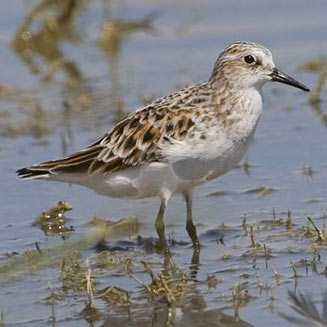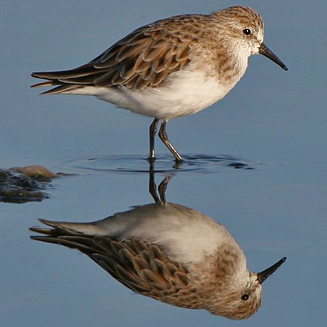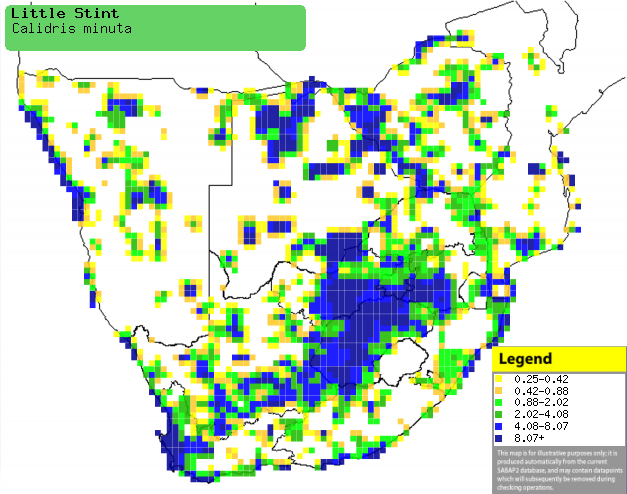|
Calidris minuta (Little stint)
Kleinstrandloper [Afrikaans]; Tsititsiti-nyenyane [South
Sotho]; Kleine strandloper [Dutch]; Bécasseau minute [French];
Zwergstrandläufer [German]; Pilrito-pequeno [Portuguese]
Life
> Eukaryotes >
Opisthokonta
> Metazoa (animals) >
Bilateria >
Deuterostomia > Chordata >
Craniata > Vertebrata (vertebrates) > Gnathostomata (jawed
vertebrates) > Teleostomi (teleost fish) > Osteichthyes (bony fish) > Class:
Sarcopterygii (lobe-finned
fish) > Stegocephalia (terrestrial
vertebrates) > Tetrapoda
(four-legged vertebrates) > Reptiliomorpha > Amniota >
Reptilia (reptiles) >
Romeriida > Diapsida > Archosauromorpha > Archosauria >
Dinosauria
(dinosaurs) > Saurischia > Theropoda (bipedal predatory dinosaurs) >
Coelurosauria > Maniraptora > Aves
(birds) >
Order: Charadriiformes > Family: Scolopacidae
 |
 |
|
Little stint adult moulting into summer plumage,
Spitskop Dam, South Africa. [photo Trevor Hardaker ©] |
Little stint, West Coast National Park, South
Africa. [photo Trevor Hardaker ©] |
Distribution and habitat
Breeds in the Arctic tundra from northern Norway to
Siberia, heading south in the non-breeding season to India. Arabia and
sub-Saharan Africa. Within southern Africa it is
common in patches across the region, occurring in both coastal and inland
wetlands, such as intertidal mud and sand flats, and temporary pans.
|
 |
|
Distribution of Little stint in southern Africa,
based on statistical smoothing of the records from first SA Bird Atlas
Project (©
Animal Demography unit, University of
Cape Town; smoothing by Birgit Erni and Francesca Little). Colours range
from dark blue (most common) through to yellow (least common).
See here for the latest distribution
from the SABAP2. |
Predators and parasites
Movements and migrations
Long distance migrant, arriving in
southern Africa mainly in August, with numbers peaking from
October-December. Returns to the breeding grounds from mid-February
to late March (birds in the northern parts leave later). While in in
southern Africa it is highly nomadic,
moving in search of recently flooded and overgrown habitats.
Food
It eats mainly small invertebrates such as midges,
crustaceans and gastropods, doing most of its
foraging in very shallow water or mud. It searches for animals with its sharp
eyesight before rapidly plucking them up with its bill. It is the only wader light enough to
forage on the algal mats of commercial salt pans, usually concentrating on the
downwind margin of the pan.
Threats
Not threatened, as it has adapted well to the introduction of
man-made habitats, such as salt works, dams and sewage works.
References
-
Hockey PAR, Dean WRJ and Ryan PG 2005. Roberts
- Birds of southern Africa, VIIth ed. The Trustees of the John Voelcker
Bird Book Fund, Cape Town.
|
